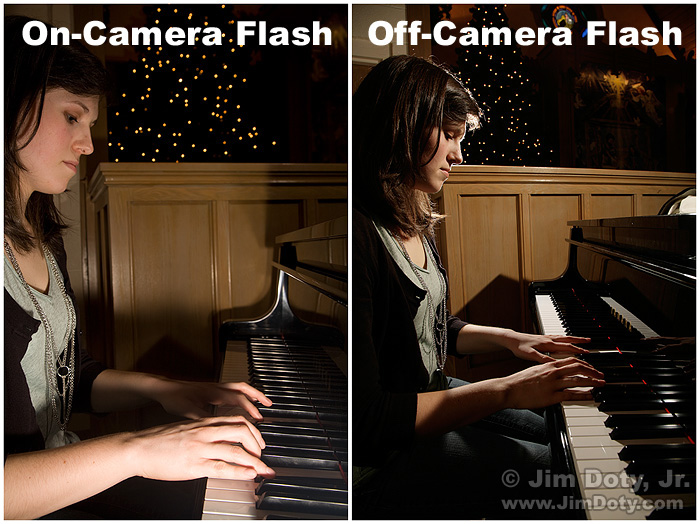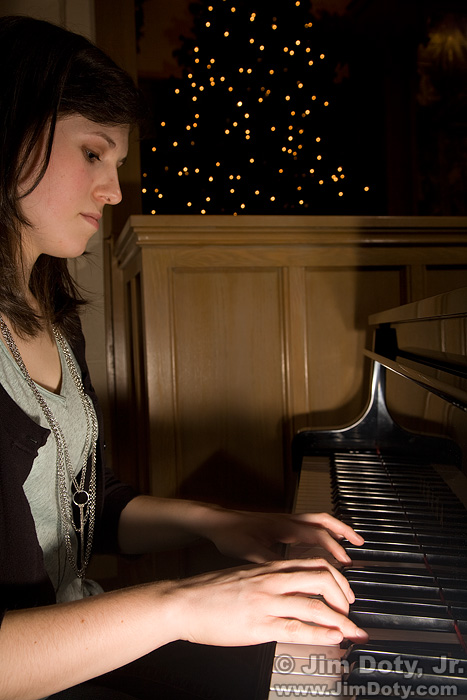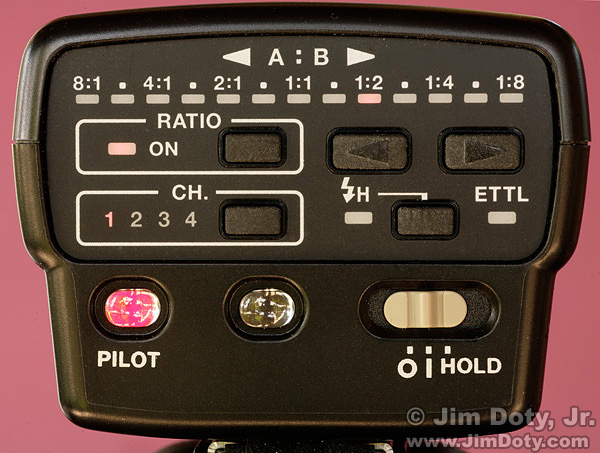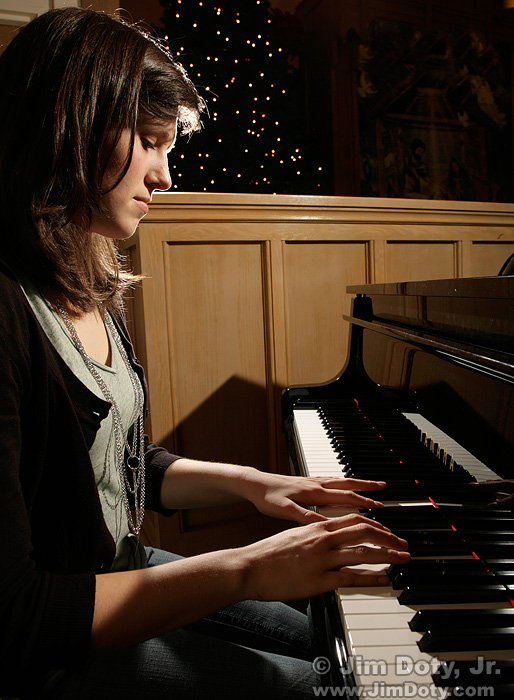Off-camera flash can provide more pleasing light and a much more dramatic photograph than on-camera flash. Using two off-camera flash units provides even more dramatic lighting possibilities.
This was an unplanned, spontaneous photo shoot. I had a camera, lenses, flash and infrared remote with me, and a good friend had a camera and compatible flash so we had everything we needed.
I took a dozen photos in several kinds of light. I began with the available ambient light, but it didn’t give me the kind of image that I wanted.
I put a flash on the camera, but that didn’t work either, as you can see from the photo above. There are several problems, one of the most obvious being “light fall off”. With all light sources, including flash units, “light falls off with the square of the distance”. In mathematical terms, every time you double the distance to the light source, you have 1/4 as much light. In photographic terms, every time you double the distance from the light source, you lose two “stops” of light. (You can learn more about stops in this article.)
To get the perspective I wanted in the above photo, the wide angle lens needed to be close to the keyboard, which means the on-camera flash was also close to the keyboard. Thanks to light fall off, the light intensity on Jennifer’s right arm is higher than on her face which is farther from the flash. The far end of the keyboard is darker yet. In addition, I didn’t like the shadows that were created by the location of the flash. The low angle of the flash is different (and sometimes useful) but not what I was looking for in this photo. The camera position is off too, being a bit askew, and the angle of the keys isn’t what I wanted either. Not at all the the look that I wanted. I could have moved the camera/flash, but then I wouldn’t get the angle of view and perspective that I wanted. The only solution was to leave the camera where it was and get the flash off the camera.
I put an infrared remote in the hotshoe of my camera, set my flash unit to “slave” (see Part 1 of this series) and gave the flash unit to John, a good friend and fellow photographer. John uses compatible Canon gear so we used his flash unit too.
John held one flash unit up and to “camera right” so it would throw even light on Jennifer. We put the second flash unit on small stand and placed it on the divider. We chose a location angle behind Jennifer’s face so it would be hidden from the camera, but backlight her hair, rim light her face, and backlight her hands on the keyboard. It took several tries to get the camera position and the position of the flash units just the way we wanted them. The image the three of us created was a dramatic improvement over the earlier photos.
If I were doing this today, I could have just as easily done this with radio-controlled speedlites and a radio transmitter.
Be sure to read Part 1 and Part 2 in this series. More information on flash photography, off-camera flash, light fall off, stops, flash exposure, perspective, point of view, and portrait photography are in Digital Photography Exposure for Dummies, one of the highest rated photography books at Amazon.com.
Originally written November 3, 2011. Updated December 13, 2015.
Article Links: Off-Camera Flash Series
“How To” Series: Off-Camera Flash – Series Introduction
Some of the Best Off-Camera Flash Equipment
Radio Controlled Speedlites: Yongnuo YN600EX-RT vs Canon 600EX-RT
Light Modifiers (Softeners) for Speedlites
Putting Together a “Studio in a Backpack”
How To Set Up a Halo Softbox or Umbrella with an Off Camera Speedlite
Photo Shoot: Using a Halo Softbox with a Yongnuo Radio Controlled Flash System
Environmental Portraits and Off-Camera Flash, Part 1
Environmental Portraits and Off-Camera Flash, Part 2
Environmental Portraits and Off-Camera Flash, Part 3
AlienBees: High Quality, Economical Studio Lights
Using the Histogram to Check Studio Flash Exposures
Book Links
To learn more about flash, off-camera flash, studio lights and a whole lot more, read Digital Photography Exposure for Dummies, one of the highest rated photography books at Amazon.com. Learn more here and order it here.
Read the article Excellent “How To Photograph People†Books for the best books on people and portrait photography




